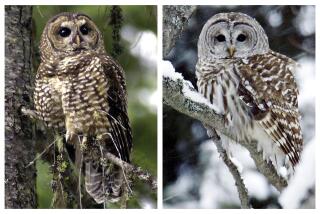Plan for Winter Windmill Idling May Save Birds
- Share via
Windmills in the Altamont Pass near Livermore will be partially shut down this winter to protect birds that have been flying into turbine blades and dying in large numbers.
This is the first time since the wind farm opened 24 years ago that the operation will be curtailed to protect migrating birds and raptors, such as golden eagles, red-tailed hawks and Western burrowing owls.
The Alameda County Board of Supervisors gave preliminary approval to the seasonal shutdown and other measures this month -- steps that went beyond what the wind energy industry supported but that didn’t completely satisfy environmentalists either.
The high number of bird deaths prompted county officials to place a moratorium in 1998 on expanding electrical capacity at the Altamont Pass Wind Resource Area -- one of the biggest providers of wind energy in the state, with about 5,000 turbines.
A 2004 study estimated that 1,766 to 4,721 birds, including 881 to 1,300 raptors, die each year in Altamont Pass. The migratory birds killed in the pass include Western meadowlarks, Pacific-slope flycatchers and yellow warblers.
“The ongoing harm to protected bird species is serious and unacceptable,” said Atty. Gen. Bill Lockyer in a July 6 letter to the county. “Because the [wind farm] is the largest of its kind in the world, what happens here could set an important precedent for how these issues are addressed elsewhere in California and the United States.”
Local and state government officials, wind industry representatives and environmentalists believe that replacing turbines with taller ones may be part of the solution to cut bird deaths.
“With the new generation of windmills or turbines, you put them up much higher. With blades up 30 meters or more, you’ll be out of the bird-flight zone,” said Jeff Miller, a representative with the Center for Biological Diversity in San Francisco, one of the groups that appealed a county decision 18 months ago to renew permits for wind-farm operators.
He said many raptors are dying in Altamont Pass because they don’t see the turbines’ spinning blades as they swoop down to hunt for mice, gophers, squirrels or rabbits.
Miller said that bird safety could further be improved by erecting the new turbines out of flyways. In addition, he noted that the new turbines are larger and generate more power than earlier models, so fewer of them are needed.
On July 7, the supervisors voted 4 to 0, with one abstention, to require a seasonal shutdown. Under the plan, half of 4,000 turbines up for review would be shut down for two months on Nov. 15. When those are turned back on, the other half would be turned off for two months.
Environmental groups and Lockyer wanted all 4,000 turbines shut down from Nov. 15 to Feb. 28.
The county plan also calls for 100 of the deadliest turbines for birds to be taken out of service immediately. Environmental groups and Lockyer wanted 300 of the most dangerous windmills shut down this year.
As part of the plan, the county would hire consultants, paid by wind-farm operators, to monitor the effects on birds of existing and new turbines, and of the seasonal shutdown, said Steve Buckley, assistant planning director for Alameda County.
Buckley said consultants would also monitor the benefits of moving rock piles left over from the installation of the turbines. The piles provide habitat for rabbits, squirrels and other animals that the birds hunt.
The county plan also calls for all wind turbines to be replaced within 13 years.
Miller said his group would like this to happen sooner if it turns out that taller turbines reduce bird kills.
“It is by far the strictest windmill program in the country,” said Chris Gray, chief of staff for Alameda County Supervisor Scott Haggerty. “No one else has the monitoring we have. No one else has done a seasonal shutdown. No one else has identified the worst turbines.”
Steve Stengel, spokesman for FPI Energy in Juno Beach, Fla., which owns more than 2,000 of the turbines with partners, declined to speculate whether the seasonal shutdown would reduce bird deaths.
The Alameda County measure outlines the breadth and goals of the plan. A more detailed measure that will implement that vision through permits and various regulations is scheduled to come before the board Sept. 22.
“There’s a lot of work that needs to be done between now and Sept. 22,” Stengel said. “Our position is that we’re moving forward and that is a good thing.”
He praised the plan’s call for the immediate formation of a scientific review committee to study the issue.
Within the past year, FPI Energy has replaced 169 obsolete turbines and shut down 100 others identified as high-risk for birds, Stengel said.
“We’ve said you have to strike a balance between reducing raptor kills and allowing companies to continue producing clean, renewable energy that Californians want and allow the companies to continue to operate in an economically viable manner,” Stengel said.
Miller, of the Center for Biological Diversity, said he believes that the turbine companies should be required to contribute $6.5 million toward purchasing nearby habitat to compensate for the large number of bird deaths over the years.
Lockyer’s letter noted that the California Energy Commission estimated that 17,000 to 26,000 raptors have been killed by the turbines since the wind farm opened.
A consultant’s report to the commission said resolving the problems in the Altamont Pass could help the state meet its goal of supplying 20% of its electricity through renewable energy by 2010.
Claudia Chandler, assistant executive director of the commission, said the state obtains 11% of its energy through renewable sources, such as wind, solar, geothermal and biomass.
More to Read
Sign up for Essential California
The most important California stories and recommendations in your inbox every morning.
You may occasionally receive promotional content from the Los Angeles Times.













